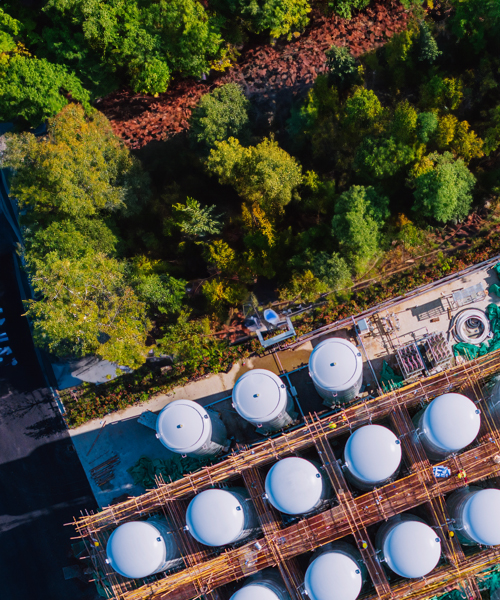February 06, 2025 • 6 min read
Building a better supply chain to scale green hydrogen
The levelized cost of green hydrogen must come down to deliver large scale decarbonization for heavy industries. Leveraging digital tools and strengthening global relationships with suppliers could help make hydrogen more commercially competitive against carbon-based fuels.
Hydrogen is at a pivotal point in delivering on its promise as an alternative to fossil fuels and a major contributor to the energy transition.
In Europe, there are currently more than 600 low carbon hydrogen projects underway according to GlobalData figures. However, there is great potential for more growth if the levelized cost of hydrogen (LCOH) is reduced to make it competitive as a viable alternative fuel.
Craig Bennett, Senior Director of Supply Chain Management, explains how building better partnerships could facilitate the growth of the hydrogen industry, even among supply chain turbulence.
How do we approach working with suppliers to enhance project delivery and reduce costs?
Worley is currently developing a suite of green hydrogen products that will provide standardized package plant solutions.
We recognize the value of partnering with major equipment suppliers to integrate their expertise and develop a minimum viable product (MVP). We merge our collective expertise, focusing on real value, taking out unnecessary cost and time, and identifying, apportioning and addressing risk with our solution.
We seek to optimize cost and schedule. The traditional approach for legacy oil and gas projects involves a lengthy competitive process for each project which while commercially rigorous, can sometimes lead to varied outcomes. For our hydrogen product, we recognize that a substantial portion of the project cost will be in materials and equipment.
We recognize the significant expertise within the companies we work with and see opportunities to better leverage this knowledge across our value chain to enhance our offerings. So, the approach was to select appropriate partners – market leading companies in the industry – and collaborate so that they help codevelop our product. By doing so early, we get their insights, which focus on MVPs, lowest cost and best speed to market.
What strategies do we employ to manage supply chain risks, especially in the context of global disruptions?
Channeling most of our product supply chain demand through trusted partners lets us draw on their expertise not just in engineering, but also global intelligence. It really helps us close the loop on key issues.
Working directly with manufacturers helps us address challenges at their source, overcoming the commercial barriers that often limit collaboration in traditional environments.
For our standardized solution, we developed a set of terms and conditions that apportion risk by removing some of those contingencies in price. If we codevelop the products using the partner’s expertise and their product designs off the shelf, we effectively integrate risk management into design. This lets us leverage the suppliers’ expertise well in advance.
How do we leverage digital tools and data analytics to improve supply chain efficiency and transparency?
Across the global supply chain, significant efforts are underway to enhance and optimize the digitization of Worley’s tools and systems through a targeted program.
As part of our partnership approach with key suppliers, this program avoids duplication, shifts the focus from transactions to collaboration and provides real time data. This enables us to proactively manage risk and offer exceptional reporting to support our customers in making informed decisions.
Typically, we work with partners on a case-by-case basis. While system optimization isn’t the focus, digitized tools and systems will help streamline processes by shifting transactional activities to the appropriate place, reducing double handling and inefficiencies.
We aim to develop a more efficient approach that also includes real time reporting. Knowing the real time status of your supply chain lets you react to risks better, whether that’s global market disruptions or scheduling issues.
Can you provide examples of successful supply chain optimization initiatives that we’ve implemented in recent projects?
We’ve invested considerable time and resources to negotiate and finalize terms, conditions and master service agreements (MSAs). These provide a strong commercial foundation for our standardized solution.
The typical process takes up to four months on a project-by-project basis, often reaching the same outcomes repeatedly – but with our solution, we now limit this to localized adjustments for customer contracts only. We focused on streamlining the sourcing process by identifying partners. This led to the establishment of MSAs; a significant time saver with considerable commercial benefits.
We’ve successfully collaborated with major equipment suppliers to design our MVP. In my experience, this level of partnership is a groundbreaking achievement.
What role does sustainability play in our supply chain optimization efforts, and how is it integrated into procurement and logistics?
By standardizing equipment design and processes, we can enhance production, streamline transportation, and simplify installation. This approach reduces the need for bespoke facilities, making operations more sustainable and efficient.
We’ve collaborated with our global logistics team to integrate transportability into design, ensuring the equipment we create is efficiently and effectively transportable.
There is more we can do. Now that we’re better positioned to leverage our partners’ supply chains, we can ask more targeted questions. Where are their products made? Are they made in sustainable ways? We address these aspects on projects, but there’s significant opportunity to enhance our insights and explore them in greater depth. With established partners, we build the trust to be able to do that.
Worley’s purpose is delivering a more sustainable world. Standardization saves time, optimizes resources and speeds up the supply chain.
How does our approach to supply chain optimization support the scalability and standardization of green hydrogen projects?
The standardized solution effectively does this by design. We partner with strategic suppliers to develop a resourceful MVP solution, allowing standardization for multiple projects on a global scale. By leveraging a collaborative network of Worley, suppliers and SMEs, we foster ongoing innovation and improvements that directly benefit green hydrogen projects, ensuring scalability and efficiency.
We also recognize the advantage of having more than one partner per product, so we can spread that workload if we need to and bring in different expertise.
I believe the product meets market needs, particularly in green hydrogen, where standardization can play a vital role in reducing costs and accelerating project schedules.
Customization by major operators often reduces product effectiveness due to a lack of standardization, increasing prices and delaying timelines.
We need to strike the right balance to ensure customers recognize an off the shelf product as the ideal solution and have confidence choosing it.







